The iPhone 5 Review
by Anand Lal Shimpi, Brian Klug & Vivek Gowri on October 16, 2012 11:33 AM EST- Posted in
- Smartphones
- Apple
- Mobile
- iPhone 5
GPU Analysis/Performance
Section by Anand Shimpi
Understanding the A6's GPU architecture is a walk in the park compared to what we had to do to get a high level understanding of Swift. The die photos give us a clear indication of the number of GPU cores and the width of the memory interface, while the performance and timing of release fill in the rest of the blanks. Apple has not abandoned driving GPU performance on its smartphones and increased the GPU compute horsepower by 2x. Rather than double up GPU core count, Apple adds a third PowerVR SGX 543 core and runs the three at a higher frequency than in the A5. The result is roughly the same graphics horsepower as the four-core PowerVR SGX 543MP4 in Apple's A5X, but with a smaller die footprint.
As a recap, Imagination Technologies' PowerVR SGX543 GPU core features four USSE2 pipes. Each pipe has a 4-way vector ALU that can crank out 4 multiply-adds per clock, which works out to be 16 MADs per clock or 32 FLOPS. Imagination lets the customer stick multiple 543 cores together, which scales compute performance linearly.
SoC die size however dictates memory interface width, and it's clear that the A6 is significantly smaller in that department than the A5X, which is where we see the only tradeoff in GPU performance: the A6 maintains a 64-bit LPDDR2 interface compared to the 128-bit LPDDR2 interface in the A5X. The tradeoff makes sense given that the A5X has to drive 4.3x the number of pixels that the A6 has to drive in the iPhone 5. At high resolutions, GPU performance quickly becomes memory bandwidth bound. Fortunately for iPhone 5 users, the A6's 64-bit LPDDR2 interface is a good match for the comparatively low 1136 x 640 display resolution. The end result is 3D performance that looks a lot like the new iPad, but in a phone:
| Mobile SoC GPU Comparison | |||||||||||
| Adreno 225 | PowerVR SGX 540 | PowerVR SGX 543MP2 | PowerVR SGX 543MP3 | PowerVR SGX 543MP4 | Mali-400 MP4 | Tegra 3 | |||||
| SIMD Name | - | USSE | USSE2 | USSE2 | USSE2 | Core | Core | ||||
| # of SIMDs | 8 | 4 | 8 | 12 | 16 | 4 + 1 | 12 | ||||
| MADs per SIMD | 4 | 2 | 4 | 4 | 4 | 4 / 2 | 1 | ||||
| Total MADs | 32 | 8 | 32 | 48 | 64 | 18 | 12 | ||||
| GFLOPS @ 200MHz | 12.8 GFLOPS | 3.2 GFLOPS | 12.8 GFLOPS | 19.2 GFLOPS | 25.6 GFLOPS | 7.2 GFLOPS | 4.8 GFLOPS | ||||
We ran through the full GLBenchmark 2.5 suite to get a good idea of GPU performance. The results below are largely unchanged from our iPhone 5 Performance Preview, with the addition of the Motorola RAZR i and RAZR M. I also re-ran the iPad results on iOS 6, although I didn't see major changes there.
We'll start out with the raw theoretical numbers beginning with fill rate:
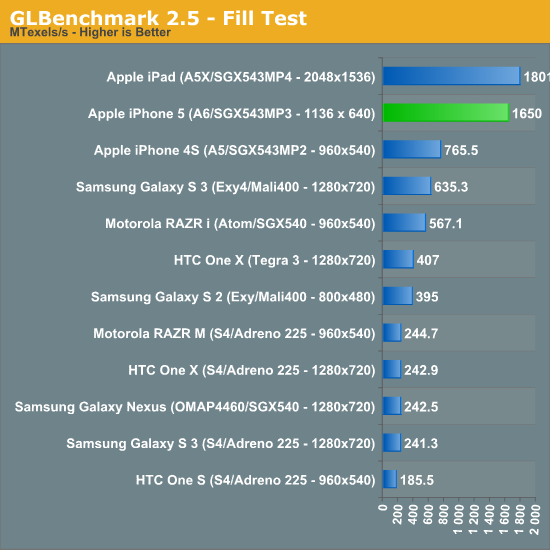
The iPhone 5 nips at the heels of the 3rd generation iPad here, at 1.65GTexels/s. The performance advantage over the iPhone 4S is more than double, and even the Galaxy S 3 can't come close.
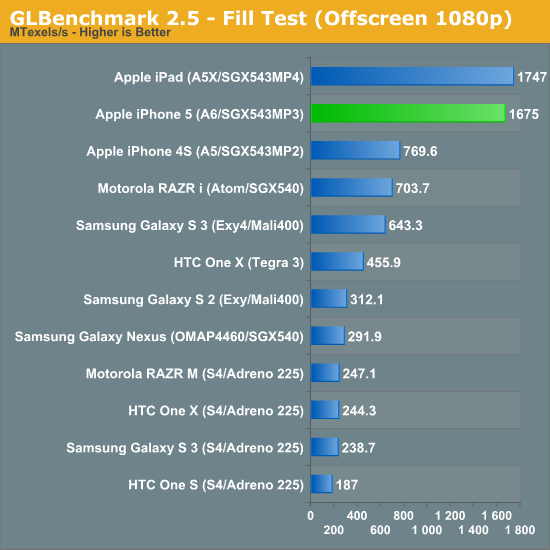
Triangle throughput is similarly strong:

Take resolution into account and the iPhone 5 is actually faster than the new iPad, but normalize for resolution using GLBenchmark's offscreen mode and the A5X and A6 look identical:
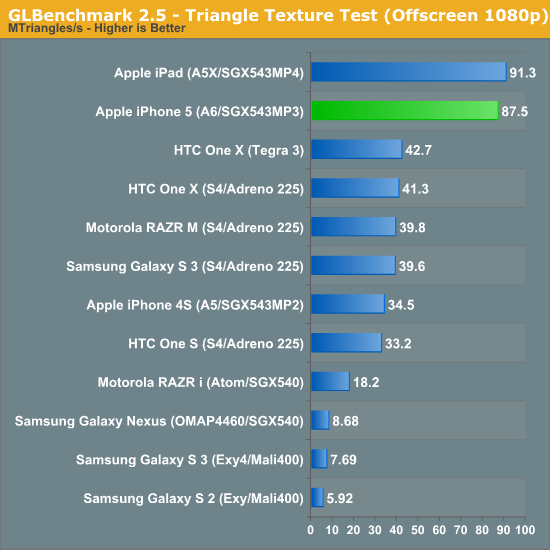
The fragment lit texture test does very well on the iPhone 5, once again when you take into account the much lower resolution of the 5's display performance is significantly better than on the iPad:
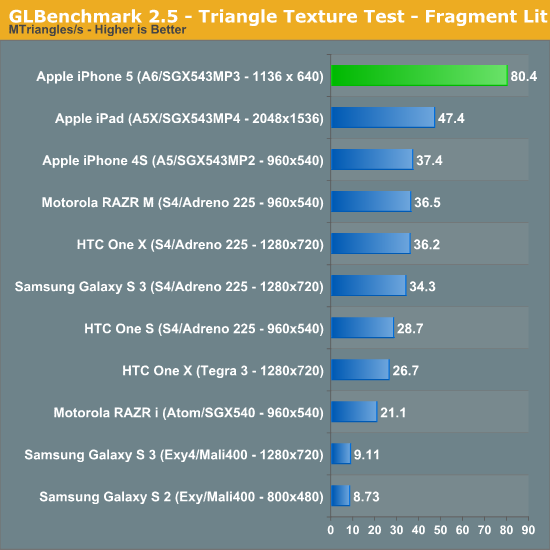
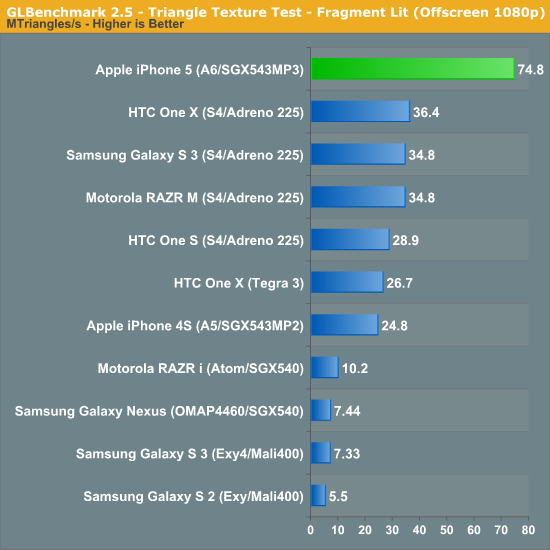

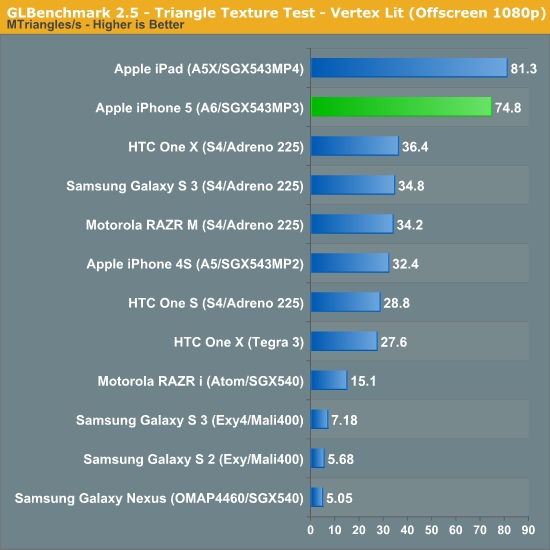
The next set of results are the gameplay simulation tests, which attempt to give you an idea of what game performance based on Kishonti's engine would look like. These tests tend to be compute monsters, so they'll make a great stress test for the iPhone 5's new GPU:
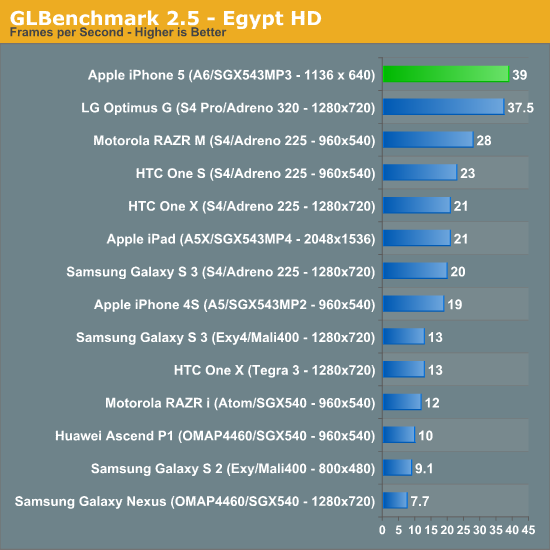
Egypt HD was the great equalizer when we first met it, but the iPhone 5 does very well here. The biggest surprise however is just how well the Qualcomm Snapdragon S4 Pro with Adreno 320 GPU does by comparison. LG's Optimus G, a device Brian flew to Seoul, South Korea to benchmark, is hot on the heels of the new iPhone.
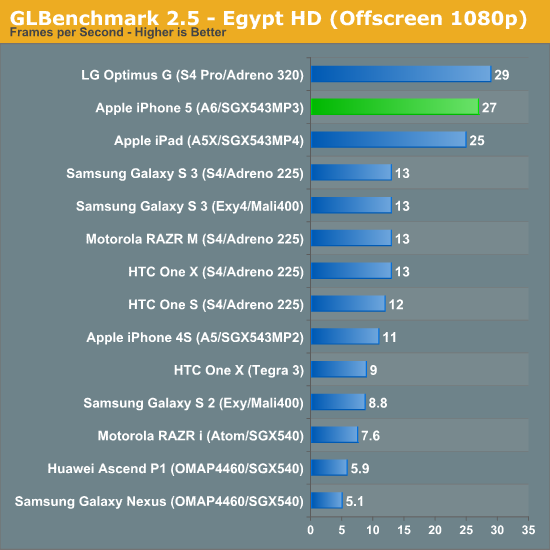
When we run everything at 1080p the iPhone 5 looks a lot like the new iPad, and is about 2x the performance of the Galaxy S 3. Here, LG's Optimus G actually outperforms the iPhone 5! It looks like Qualcomm's Adreno 320 is quite competent in a phone. Note just how bad Intel's Atom Z2460 is, the PowerVR SGX 540 is simply unacceptable for a modern high-end SoC. I hope Intel's slow warming up to integrating fast GPUs on die doesn't plague its mobile SoC lineup for much longer.
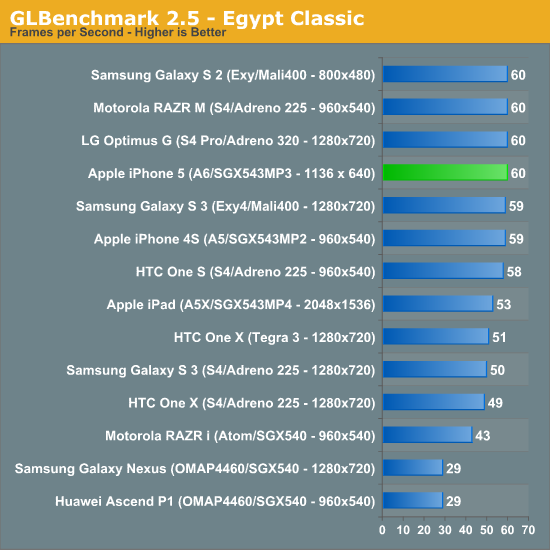
The Egypt classic tests are much lighter workloads and are likely a good indication of the type of performance you can expect from many games today available on the app store. At its native resolution, the iPhone 5 has no problems hitting the 60 fps vsync limit.
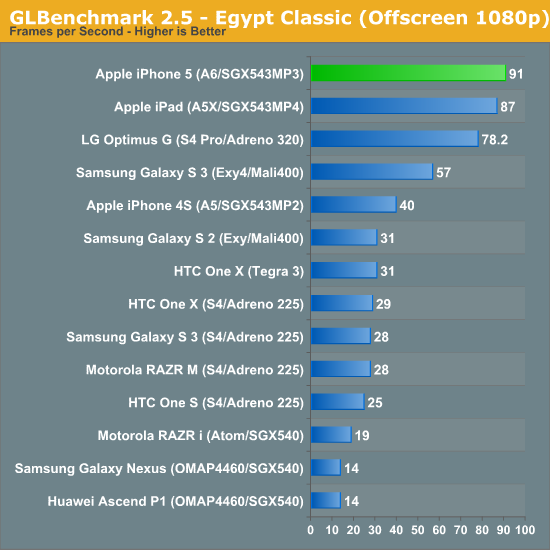
Remove vsync, render at 1080p and you see what the GPUs can really do. Here the iPhone 5 pulls ahead of the Adreno 320 based LG Optimus G and even slightly ahead of the new iPad.
Once again, looking at GLBenchmark's on-screen and offscreen Egypt tests we can get a good idea of how the iPhone 5 measures up to Apple's claims of 2x the GPU performance of the iPhone 4S:
Removing the clearly vsync limited result from the on-screen Egypt Classic test, the iPhone 5 performs about 2.26x the speed of the 4S. If we include that result in the average you're still looking at a 1.95x average. As we've seen in the past, these gains don't typically translate into dramatically higher frame rates in games, but games with better visual quality instead.











276 Comments
View All Comments
KPOM - Wednesday, October 17, 2012 - link
However, Apple made a point about anodizing in its display. Also, Apple has historically placed a premium value on industrial design so it is interesting to read more specifics. What has struck me about Apple is how much time they devote to things people don't notice consciously or will never see on a spec sheet, but which can unconsciously affect the user experience. The aluminum has a nice feel to it, and I can see why Apple would forgo putting a resin coating on it, even though it would make it less susceptible to scratching. Understanding the physics helps make clear what kind of compromises Apple needs to make.phillyry - Sunday, October 21, 2012 - link
As per emotional input:I actually look for this in the review and podcasts because it colours the facts.
While I find the facts to be interesting and a good way to pass the time, at the end of the day my purchase decision, like those of human beings in general, will be largely guided by the sentiment of the matter.
People want to know how happy others are with their devices. Just facts alone lack humanity. I personally love hearing opinions, side comments and anecdotes that give me insight into the thoughts, feelings and experiences of people who's opinions I hold in high regard, such as anand and the gang.
There's something to be said for the qualitative experience that comes with the daily use of the device as your primary 'phone'.
Many others may also be looking to hear the comradery, jest, and fun-casual tone that you can get on this site when these guys just let their opinions out or go off on technical tangents. If you listen to the podcasts it'll all make more sense.
phillyry - Sunday, October 21, 2012 - link
P.S. the feeling that someone else, like anand, has about the device is also important because, if you are considering buying one of these things than you're going to have it for a couple of years and won't want to feel stuck with it.Spunjji - Friday, October 19, 2012 - link
I have to agree here... I already know how anodizing works (not specialist knowledge, we were taught in high-school...) and even if I didn't, I'm not sure a 'phone review is the best place to learn. An outside link would have sufficed. The whole thing does basically say that Apple had no choice in the matter unless they change the design, and that's really the point there. They should have changed the bloody design.arghhh - Tuesday, October 16, 2012 - link
How is it as a phone? Iphone never has been good at its primary function (I take an old clamshell over most smartphones in that regard).Arbee - Tuesday, October 16, 2012 - link
Brian Klug covered voice quality in this writeup, and AT's previous iOS 6 review covered the new voice call features. The upshot is it's at least as good as any other smartphone, even if no cellphone can replace a hardwired slab of mid-60s AT&T bakelite :)manik. - Tuesday, October 16, 2012 - link
Awesome read.Tangey - Tuesday, October 16, 2012 - link
The gpu comparison table shows the new iPad running @200mhz, it actually runs @250mhz ( as did the gpu in the ipad2). In a previous article you used this incorrect 200mhz as a reference point to determine that the iphone5 was running its gpu @266mhz.My calculations based on the iphone5's performance relative to the ipad3 @ 250mhz, indicate to me that the 543mp3 in the iphone5 is running in excess of 300mhz, most likely 325mhz, which also happens to be an exact divider of the 1.3ghz clock of the CPUs.
DustoMan - Tuesday, October 16, 2012 - link
Have you ever looked into why phones from certain manufactures are so picky about their chargers? I've had phones from HTC, Motorola, and Samsung and I've had three wildly different experiences when it comes to what chargers will work in what devices. When I had an HTC Incredible, I could stick pretty much anything I wanted to it and it would charge. If the charger didn't have much current, it would charge slower than a charger with my current. My Galaxy Nexus would work with a few of my chargers, but the oddest thing would happen when I would try connecting it to a Griffin car adapter that had the 1.5A plug necessary to charge a first gen iPad. The only plug that would charge it consistently was a car adapter that I purchased that was branded Samsung. Even an adapter that Verizon sold me as being compatible wouldn't work. Finally the worst offender is my wife's Droid 2 Global. It will only charge with a Motorola adapter. Adapters that work with my Galaxy Nexus, which you would think would need chargers with a higher current, wouldn't work. To charge her phone on my PowerMat, I have to plug the phone into a reserve battery and then use the Powermat to charge that reserve battery while it's charging her phone. Stupid huh?zephxiii - Tuesday, October 16, 2012 - link
Yes i recall Motorola's earlier microUSB equipped phones to be very picky....especially if the battery went completely flat as it seemed like only Motorola chargers (or compatible) would breathe life back into them.